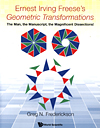- About MAA
- Membership
- MAA Publications
- Periodicals
- Blogs
- MAA Book Series
- MAA Press (an imprint of the AMS)
- MAA Notes
- MAA Reviews
- Mathematical Communication
- Information for Libraries
- Author Resources
- Advertise with MAA
- Meetings
- Competitions
- Programs
- Communities
- MAA Sections
- SIGMAA
- MAA Connect
- Students
- MAA Awards
- Awards Booklets
- Writing Awards
- Teaching Awards
- Service Awards
- Research Awards
- Lecture Awards
- Putnam Competition Individual and Team Winners
- D. E. Shaw Group AMC 8 Awards & Certificates
- Maryam Mirzakhani AMC 10 A Awards & Certificates
- Two Sigma AMC 10 B Awards & Certificates
- Jane Street AMC 12 A Awards & Certificates
- Akamai AMC 12 B Awards & Certificates
- High School Teachers
- News
You are here
Ernest Irving Freese's Geometric Transformations: The Man, the Manuscript, the Magnificent Dissections!

Publisher:
World Scientific
Publication Date:
2018
Number of Pages:
197
Format:
Paperback
Price:
38.00
ISBN:
9789813220478
Category:
General
[Reviewed by , on ]
Salim Salem
01/21/2019
Ernest Irving Freese’s Geometric Transformations does not just uncover a mathematical gem. It is also a piece of art and a mind-puzzling set of ingenious dissections done by a master of architectural drawings and amateur mathematician. Greg Frederickson is the expert “gemologist” who knows how to polish and reshape his gem so it shows all its hidden beauty and allows the startled reader to enjoy discovering it. In this book Frederickson publishes Freese’s manuscript and inserts explanations to help the reader to understand these geometric dissections.
The twenty chapters fall in two parts. The first contains an introduction and three chapters in which Fredrickson explains geometric dissections, the life and adventures of Ernest Irving Freese, and the history of his 200-page manuscript. The second part is the manuscript itself, Fredrickson arranged by themes and complemented by commentaries on each dissection and its state of the art.
The dissections of triangles can be found in chapters 5, 6, 7 and19, those of squares, crosses and rectangles are explained and drawn in chapters 7 and16. Pentagons are dissected in chapter 8, hexagons in chapter 9, octagons on chapter 10, enneagons on chapter 11, decagons on chapter 12, dodecagons in 13. Many-sided polygons are the theme of all other chapters except the one page twentieth chapter, which is reserved to look at the future headways opened by this manuscript. Frederickson asks whether Fresse’s constructions are done with smallest number of pieces and leaves it to the reader’s imagination to improve on this work.
This book contains a lot of geometry, but Freese’s manuscript is not concerned with the theory of dissection or with proving theorems about it. It is a practical book that shows the beauty of dissections and how we can get from a polygon to another by cutting it to pieces and recollect them in some special way. The book is written in a very elegant style, and nicely presented. Readers do not have to follow its structure they can start anywhere and go to any chapter. Freese’s manuscript was photographed and wasn’t altered in any way this preserved its beauty. Freese’s drawing ingenuity and it shows how meticulous he was.
For those people who are interested in geometry or in geometric dissections and for those who admire puzzles and recreational mathematics this book is a must.
Salim Salem is Professor of Mathematics at the Saint-Joseph University of Beirut.
- The Rich History of Geometric Dissections
- The "Wild Adventures" of Ernest Irving Freese
- Techniques, Special Properties, Hardness
- Freese's Title Page and Descriptive Index
- Isosceles Triangles
- Equilateral Triangles
- Squares, Crosses, Rectangles
- Pentagons and Pentagrams
- Hexagons and Hexagrams
- Octagons and Octagrams
- Enneagons (Nonagons)
- Decagons and Decagrams
- Dodecagons and Dodecagrams
- Many-sided Polygons
- Miscellaneous Figures
- More Crosses
- More Miscellaneous Figures
- Mixed Polygons to One
- Special Triangles
- Log in to post comments




